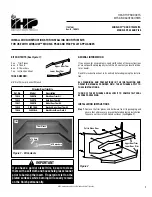
(See figure 26). This should close the ignition circuit and simultaneously open the gas
tap allowing the gas to flow to the pilot. Wait a few seconds while the air is purged. The
electronically generated sparks should light the pilot. The pilot should then light the
main burner at its low setting. There may be a delay of up to four seconds between the
pilot lighting and ignition of the gas at the main burner. This is normal and is due to the
time required to fill the main burner compartment with sufficient gas for ignition.
3.
When the burner is operating properly, gradually turn the control pivot bracket anti-
clockwise. The burner flames should gradually increase until the pivot bracket is nearly
at its furthest anti-clockwise rotation. Rotating further until the pivot bracket comes to a
stop should then turn the burner and pilot off.
4.
If the above checks are satisfactory, continue with the installation. If not, check the
control and ignition circuitry and components as described in the servicing section of
this guide.
10.3 Inlet pressure check.
The appliance is pre-set to give the correct heat input at the inlet pressure shown in
section 2 of this manual. No adjustment is necessary.
1.
Check the inlet pressure by fitting a pressure
gauge at the test point. The test point is on the inlet
‘T’ connector (See figure 27). Check the pressure
with the appliance alight and set at maximum
output.
2.
After checking, turn off the appliance. Remove
the pressure gauge and replace the test point sealing
screw.
3.
Relight the appliance. Turn to the maximum
output position and test around the sealing screw for
gas soundness with a suitable leak detection fluid.
When the above checks from section 10.2 and 10.3 have been completed close the
isolating valve on the inlet ‘T’ connector
.
Page 29
INSTALLER GUIDE
©
Baxi Heating U.K. Limited 2007.
Figure 27. Pressure test point
















































